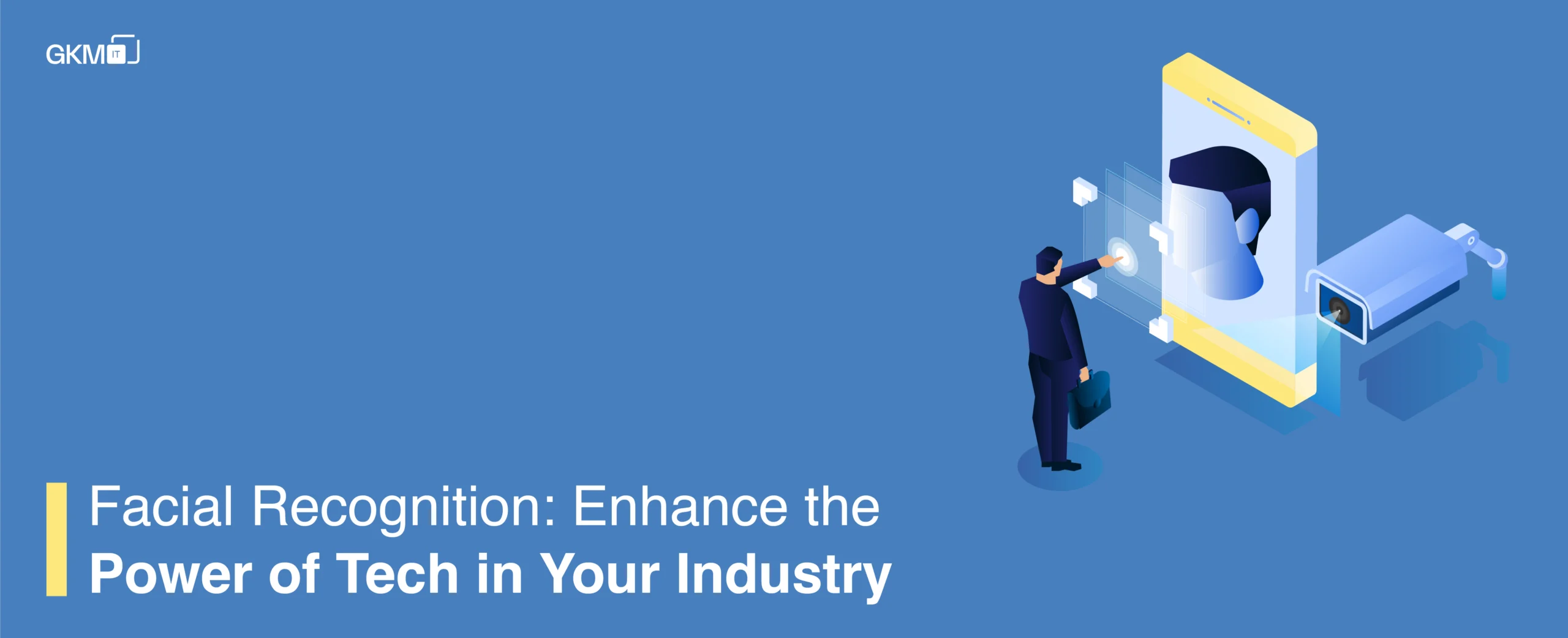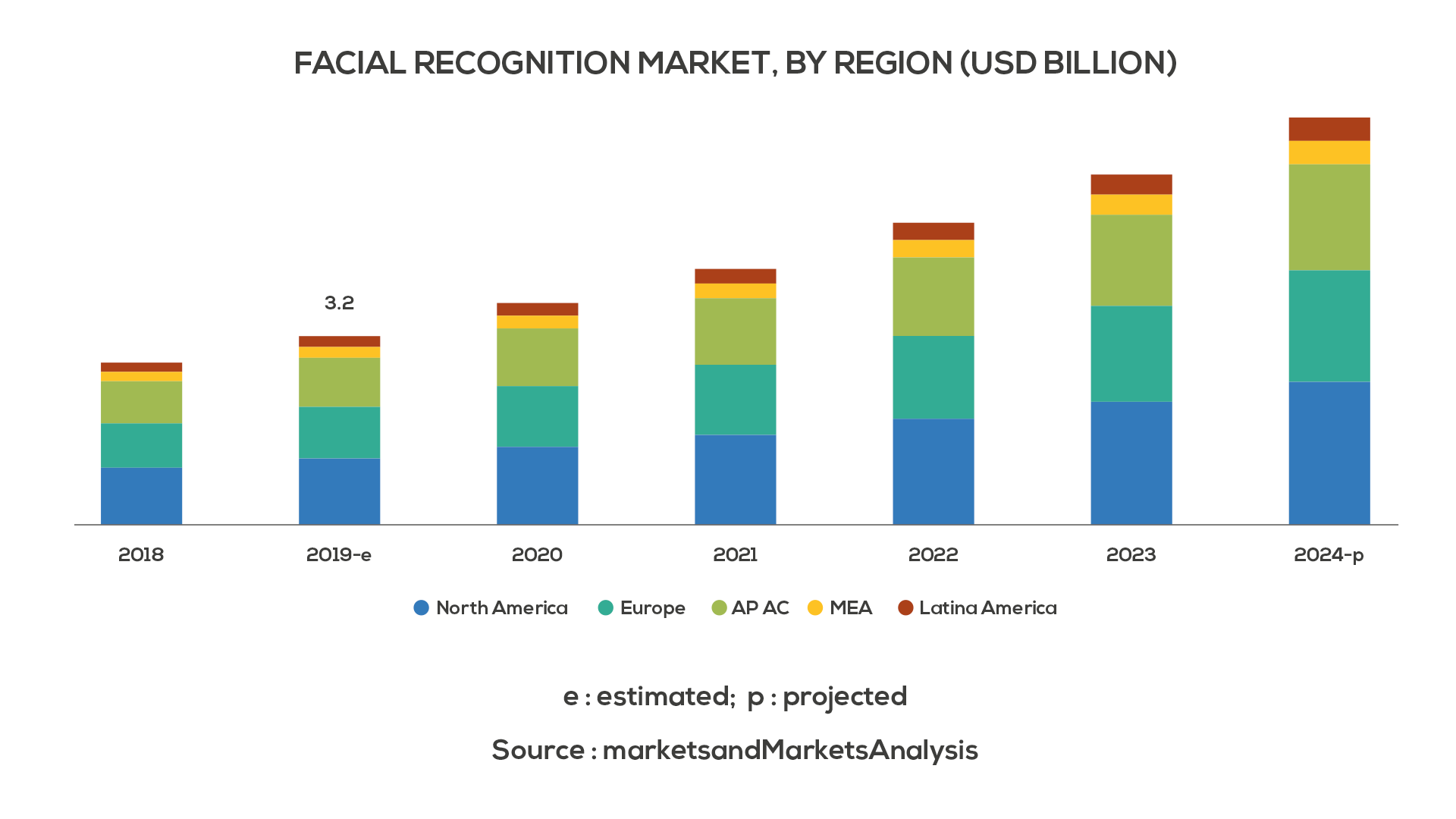
Facial Recognition: Enhance the power of tech in your industry
What is facial recognition?
The technology verifies, authorizes, and authenticates an individual’s identity using the face. Facial recognition works by capturing and analyzing facial features or patterns from the person’s face. It is established as a preferred biometric benchmark. According to the 2019 research report, the estimated current facial recognition market value is $3.2 billion.
By 2024, revenue in the facial recognition market is expected to grow by $7 billion—a compound annual growth rate of 16% from 2019 to 2024. The top three leading consumer industries are security, health, marketing and retail.

Companies and governments have adopted facial recognition technology across the world, and among them, the USA and China are leading customers. Many technology companies like Google and Facebook have invested heavily in the development of this technology. Both companies use this technology for their photo-based applications.
Both Facebook and Google have reached an accurate face detection level of 97.35% and 99.63%. Facial recognition has a tremendous opportunity with tech support, especially in fields like emotion recognition, attendance tracking and monitoring, access control, behavioral analysis, crime, and more.
The advancement in artificial intelligence and machine learning has rocketed the growth of facial recognition. It acts as a key player and plans to integrate AI and IoT (Internet Of Things and its future scope)with facial recognition systems. Europe holds the top market position, and we expect the Asia Pacific to grow over the next five years.
How does facial recognition work?
Let’s find out how facial recognition actually works. It is a sophisticated system that involves each step having a particular specialized task as a part of the process.
During a person’s lifetime, his/her face undergoes several changes, and complex facial recognition systems consider multiple factors. Ageing, plastic surgery, cosmetics, the effect of drugs, smoking, posture, pose, image quality, etc. These factors help recognise technology’s overall accuracy as it is considered in a complex face recognition system. This process happens in two steps:
- Pre-processing stage
- Recognition stage
The pre-processing stage has further subdivisions
- Face detection and tracking
- Face alignment
- Feature extraction
- Feature alignment
What is the role of facial recognition in various industries, and how is it growing?
- Health care industries
Upliftment in various sectors in the healthcare industry is achieved by face recognition. It has improved overall patient care and helped in the following aspects
- Based on face recognition automotive, medical report access
- Reduces fraudulent insurance claims
- Smooth patient registration
- Emotion recognition to detect pain in patients
- Detectable changes in appearance through disease identification
-
Automotive manufacturers
Automobile companies embed face recognition tech to ensure driver authentication and improve ease of access, and reduce car theft. Nowadays, cars are using keyless entries using facial recognition technology. It stores driver’s profiles such as seat and steering position, vehicle speed, preferred music volume and other preferences. Ford and Intel have developed a product which only allows the owner or a family member to start the car.
- Banking and finance
The security within the banking and finance industries is supreme—banks such as HSBC, Bank of America, and Apple use facial recognition technology to authenticate customers. Or to log in to mobile banking apps or to perform various transactions. In Spain, facial recognition is used as a signature for ATM cash withdrawals to prevent fraud and eliminate PIN’s need.
- Marketing, advertising and retail
Face recognition has helped brands create and maintain individual user profiles and track their physical and online store movements effortlessly. It also recommends shopping options. Beauty brands like MAC virtually allow customers to try makeup using augmented reality.
- Aviation
Passengers have to undergo face recognition to board a flight, which will help the aviation industry get rid of fraudulent activities. Many countries have already implemented it. JetBlue is already experimenting with face recognition to authenticate passengers via face detection instead of a boarding pass.
- Hospitality
This technology has proved a boon for hoteliers to personalize their customers’ user experience to meet their needs. Using face recognition, hotels can authenticate check-in, grant room access, authorize lounges, and provide perks tailored to each customer.
- Insurance
Face recognition has made a remarkable entry in certain insurance companies by analyzing applicants’ face and providing policy quotes. Certain factors are taken into consideration, such as weight, age, smoking-related issues, BMI, and more.
- Law enforcement
Tech giants and other companies are developing facial recognition-law enforcement applications. These apps are used to identify shoplifters and curb retail crime. To curb terrorism and cybercrime, the Govt. of India issued Aadhar cards for India’s citizens. It is a unified community to devise solutions.
Companies using facial recognition
- Snapchat
- Apple
- Walmart
- Gemalto
Concerns attached to faci
al recognition
- Privacy breach
Breach of privacy is the concern of opinions. For e.g. in China, school monitors the attention level and mobile usage of students, which is a violation of privacy.
- Lack of regulations
While implementing facial recognition, citizens often see a lack of government vigilance and misuse or improper conduct of such technology.
- Less control and safety
Once you are in the database, then there is no coming back. Somebody may end up having your profile if you forfeit.
- Less of accuracy
People are concerned about facial recognition accuracy and whether there are any biases. Misidentifying someone or wrong identification can lead to falsely accusing someone by law enforcement.
Conclusion-
Post-COVID-19, the global facial recognition market size will grow from USD 3.8 billion in 2020 to USD 8.5 billion by 2025 at a compound annual growth rate (CAGR) of 17.2%. The major factors driving the growth come from the surveillance industry, increasing investments by the government and defense sector, and technology advancement across industry verticals. Some major challenges hindering the growth are face occlusion, face detection error, and lack of knowledge and awareness.
People have become tech-savvy and vigilant, and thus the face detection market is increasing daily. Tremendous growth is expected in the coming years with more advancement. The market for 3D facial recognition is up for grabs and key players to succeed in AI and machine learning. We can see a bright future in facial recognition technology.
We would like to end this by saying it is not just about facial recognition, but it is all about what you can do with the information. There are endless possibilities, so find your creative way of using face recognition that matches your needs.
Related Blogs –
Alert Top User Frustrations On Web
Top Tips To Create Engaging And Useful Chatbot
What Is Natural Language Processing Introduction To Nlp
6 Web Development Trends Every Cto Should Expect In 2021